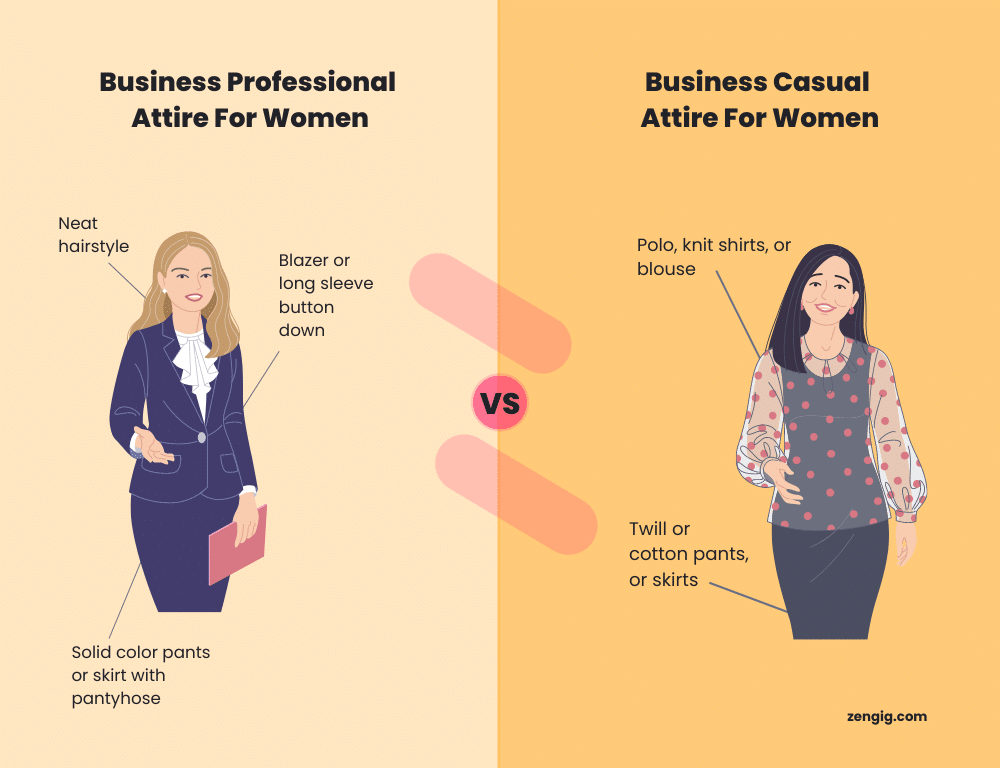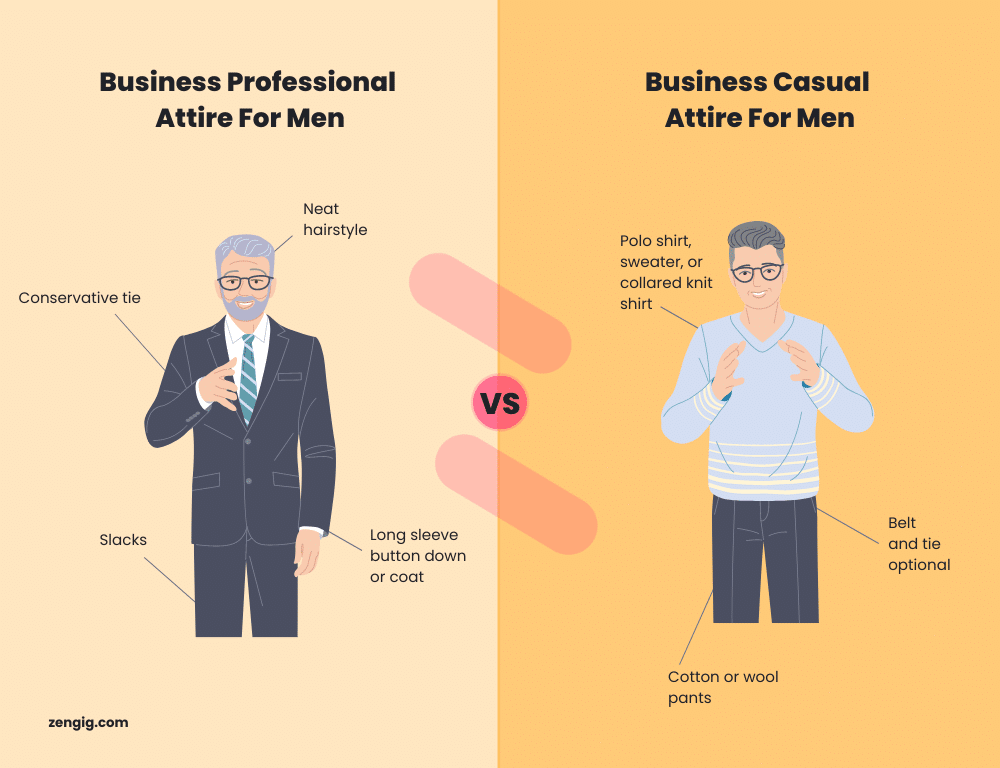Business Casual vs. Business Professional: What to Wear to an Interview

Job interviews require making an excellent first impression, so how you dress plays a significant role in setting the tone for a successful outcome. The goal is to convey a sense of professionalism, confidence, and personal style. But how do you find the right balance? What is the best way to dress for success without feeling uncomfortable or out of place? And what is the difference between business casual and business professional attire?
In this article, I’ll explain the primary differences between the two styles, provide examples, and offer valuable tips you can use.
Please keep in mind that my recommendations are for those who have yet to be advised on what to wear. If you were asked to wear specific attire, that should override any advice you read here. It’s also worth noting that you can always ask your host or primary point of contact to clarify in advance. Taking the initiative and covering your bases is always a safe option.
What should you choose and when?
First, knowing what to wear will always be dictated by where you are going and why. Let’s break down the most common interview settings where you might wonder what to wear.
In-person interview
Recommended Attire: Business Professional
While some interviews specifically request that you wear business casual attire, an increasingly common practice, you are better off being overdressed than underdressed. If your recruiter or human resources (HR) contact didn’t explicitly tell you what to wear in your interview, always go with professional business attire.
Video conference interview
Recommended Attire: Business Professional
Making a great first impression on the recruiter or hiring manager is just as important as an in-person interview. Dress to impress! Don’t misinterpret a video interview as an excuse to dress like you would at home. Unless otherwise stated, wear professional business attire.
Review our how to prepare for a zoom interview checklist to ensure you make a lasting impression on the interviewer.
Phone interview
Recommended Attire: Business Casual
If you have a phone interview coming up, you might think it doesn’t matter what you wear. While it’s true that the person on the other end of the phone won’t know what you are wearing, studies show that a person’s physical appearance can affect their state of mind. If you choose to dress down for your phone interview, be sure you are mentally “dressed for success,” even if you aren’t physically.
Use this how to prepare for a phone interview checklist to help you stand out to the hiring manager!
Business lunch, dinner, or drinks
Recommended Attire: Business Casual or Business Professional
Wearing the appropriate attire is a must if you’re invited to an interview in a restaurant or at happy hour with potential colleagues. In most cases, your company should advise you on what to wear. If they didn’t, we recommend contacting the venue where you will be eating or drinking and asking what their dress code is (if any). Let them know why, and chances are the hostess or wait staff will gladly help you out.
Company event or party
Recommended Attire: Business Casual or Business Professional
Company events can range from quirky Halloween parties where a wide range of costumes and clothing is acceptable to formal black-tie fundraising events. When attending an interview in a unique setting, it’s more important than ever to consult your company contacts for advice on what to wear. Ask those who have been there before, and make sure you gain a clear understanding of what to expect.
Business professional attire for women
The main focus of professional business attire is dressing conservatively and sophisticatedly. This type of dress is more traditional and required in a professional setting like an interview or a business meeting. Companies in industries like finance, law, government, or real estate tend to enforce this stricter dress code.
What to wear for women:
- Dark colors
- Matching suit
- Closed-toe shoes or a low heel
- Formal blouse
- Slacks or a long skirt with pantyhose
- Minimal jewelry
What not to wear for women:
- Open-toe shoes
- Khaki pants
- Short sleeve jackets
- Low-cut or tight clothing
- Clunky jewelry
Remember that your professional appearance goes beyond your attire. Make sure your hair is done, your nails are presentable, and your makeup is applied conservatively. Also, while this is likely unnecessary to point out, ensure you are clean and that your body is not the source of any foul odors.

Business casual attire for women
The goal of business casual attire is to maintain a professional appearance while balancing comfort and style. Here are some ideas on creating a polished and put-together business casual interview outfit, from dresses and skirts to pants and blouses.
What to wear for women:
- Blouses or shirts with a conservative cut
- Solid color sweaters or cardigans
- Twill or cotton skirts, pants, or dresses that fall below the fingertips
- Closed-toe shoes or peep-toe shoes
What not to wear for women:
- Ripped clothing or pajamas
- Gym or athletic attire
- Jeans or shorts
- Flip-flops, sandals, or sneakers
Although business casual attire is much more relaxed than business professional, it’s still important to look beyond the clothes you will wear. Be conscious of how you smell. Are you wearing too much perfume? Were you sweating after a hard workout? Did you just drink a large cup of coffee? It’s important to know how you present yourself beyond what the eye can see.
Business professional attire for men
With business professional attire, the goal is to convey competence, authority, and attention to detail. For men, this calls for a conservative and classic look. From suits and ties to dress shoes and accessories, we have you covered! Whether you’re applying for a dream job or refreshing your wardrobe, this guide will help you assemble a polished and professional outfit.
What to wear for men:
- Solid color, fitted suit
- Long-sleeve button-up shirt
- Conservative tie without excessive graphics or colors
- Wear dark-colored socks and black or brown dress shoes
What not to wear for men:
- Jeans or shorts
- Short-sleeve t-shirts or athletic attire
- Khaki pants
- Flip-flops, sandals, or rundown sneakers
Business professional attire for men is pretty standard across the board. A suit, button-up shirt, tie, dress shoes, socks, and maybe a nice tie clip or watch are all you need to look professional and impress your future employer. Continue to be conscious of your body odor, breath, and other vital factors while preparing for your interview.

Business casual attire for men
Dressing in business casual attire allows you to maintain a professional appearance while feeling comfortable. From collared shirts and blazers to dress pants and chinos, here are some tips on creating a stylish and professional outfit for a business casual look.
What to wear for men:
- Khaki or dark pants with a black or brown leather belt
- Cotton long-sleeve button-down shirts tucked in
- Professional-looking tie (optional)
- Leather shoes in black or brown
What not to wear for men:
- Jeans or shorts
- Short-sleeve t-shirts or athletic attire
- Tie with unprofessional images
- Baggy or loose clothing
Business casual attire for men offers a wide variety of customization. It typically allows for much more comfort than professional business attire. As always, remember that your presentability goes beyond your clothing and extends to your physical cleanliness, smell, hair, and more. Be sure to shower, brush your teeth, and if all else fails, grab some deodorant and mints before your interview..
Tips beyond attire
The way you dress is important and undoubtedly one of the first things that will be noticed about you, but there’s a lot more to a person than their clothes. The most crucial thing is to be confident in whatever attire you choose.
Imagine you are interviewing at a company that requires you to wear a suit and tie daily, but you hate dressing formally. If so, you might want to reconsider whether that company is right for you.
All in all, remember that you are unique, and so is every situation. It’s always best to follow the lead and guidance from the representatives of the company you’re interviewing with – they will always know best for their culture and environment. Good luck, and happy hunting!

